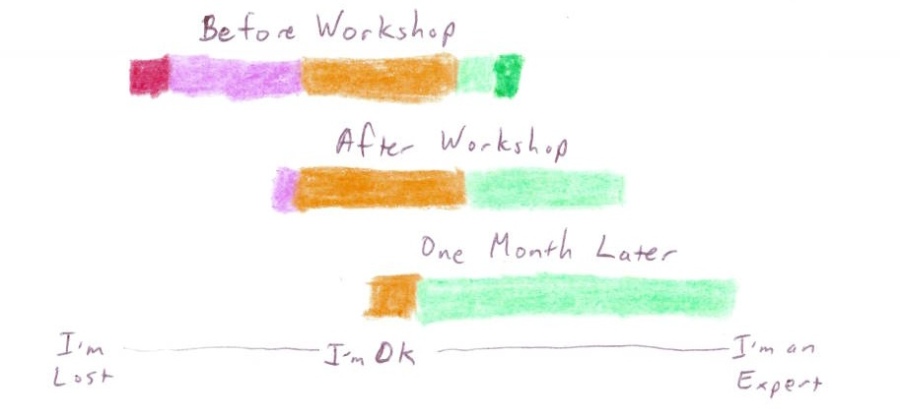A few folks have requested the questions and answers from the webinar. Since the recording failed (grrrrrrrrr), below are the questions and what I remember of the responses I gave.
Q: Interestingly, your diverging colors went from red to green, which itself is worth noting.
This is referring to the first chart in my presentation, which I did presented as a bar graph of a diverging dataset. This showed people’s responses to the question “How comfortable do you feel right now with your ability to present your data?”. I viewed “I’m lost” as a negative response, and “I’m expert” as a positive response, so I decided to color it from red to green, building on the widely used traffic light color scheme. I got the specific colors from the ColorBrewer tool, where I found a nice palette for diverging data with five values.
Q: If we’d like to preserve graphs, we’d rather use open source applications. Do you know of any that will produce creative charts, for example.
I’m a fan of open source, but not addicted to it. There are many open-source options making charts and things for graphic-designers or graph-makers. You could use OpenOffice instead of Microsoft Excel. You could use InkScape instead of Adobe Illustrator. You could use gimp instead of Adobe Photoshop. If you’re a super data nerd, the R Project is totally open too (for complex data analysis tasks). However, if your goal is to ensure you can open and edit files down the road you could think about open formats for saving the files. For instance, Illustrator opens natively works well with the open EPS format (and everything supports EPS).
Q: How many people are in this webinar?
There were about 50 people total that moved in and out of the webinar. Probably about 25 people were there for the whole time.
Q: Which technique do you think is more engaging for the general public? What makes people ask things and engage in conversation when presenting data?
It kind of depends what setting you’re engaging the public in (ie. knowing your audience). I’m a big fan of physicalizing your data for public display. Embedding your data in a physical object is a great way to make it something people can interact with and react it. You need some kind of spark to get people interested. Of course doing an interactive game can also be fun – I have a healthy respect for the near-universal appeal of carnival games. A real key is that you have to design for multiple levels of engagement… one person may be interested in a poster, while another may want to speak with you. This is hard, but there are lots of lessons to be learned from museum exhibits, which have a similar problem. You have to design your presentation for 30 seconds, or 20 minutes of engagement. Focusing on the first 30 seconds is key, because that wins you the time to elaborate to someone. Don’t forget the crowd dynamics of everything too – people always go to where there is a crowd. So once you have one of two people engaged with your data presentation, more will come over.
Q: what’s the source from that religion x writing proficiency level graph?
When talking about building to complexity, I reference an example from the OkCupid Blog. The specific post I pull from is called “The Real Stuff White People Like“. At the bottom of that post you can find the graph about religious beliefs and writing proficiency.
Q: Does this color brewer is colorblind proof?
When talking about colors, I mentioned the amazing resource called ColorBrewer. On their color selection tool you can see that they do have a checkbox for “color blind safe” palettes. The tool was made for cartographers, but their excellent color palettes are useful for almost any visual data presentation.
Q: Sorry, what was the second color tool that you mentioned after colorbrewer?
For graphic design (ie. not data representation) color schemes, I like to use ColourLovers. You can think about it as twitter for colors. Graphic designers post their favorite color palettes and then you can use them for getting nice color schemes in your designs. This is one of the “shortcut” online tools I like to point to that helps alleviate the tip-of-the-iceberg problem, because data presentation does build on so many fields of study. Steal a palette from ColourLovers and you don’t have to be a graphic design wiz!
Q: where does this mapping software come from?
The map example I show was made with the ManyEyes tool. It has a bit of a learning curve, but basically you can upload a spreadsheet and make a map out of the data it shows (among other things).
Q: when you think of creative charts, are you thinking that these are things to do with vector graphics? Or, that have to be done by hand?
As I mentioned a few times, I think that hand-made charts and pictures are vastly underrated in northern cultures. We have a tendency to think that unless graphics are “professional” looking, they can’t be accurate. We need to get over this. Hand drawn things are often easier to engage with, and can help break down any intimidation that a novice viewer may have. They work especially well for the general public, where you need to be concerned about the accessibility of your presentation to audiences with lots of different levels of visual literacy.
Q: any suggestions on map related tools beyond many-eyes?
It depends on the need. For mapping things another great tool is BatchGeo. One of the things that distinguishes it from other “geo-location” tools on the web is the it does more than just put points on a map. If you zoom out it will aggregate the geo-located points based on some attributes you select from the data you upload. This can be really useful for seeing geographic clusters or breakdowns of data.
Q: Perhaps i missed, but what tool have you used for your presentation?
I created the presentation with Prezi. I find it to be a great tool for visuals to help with telling your story. The Microsoft Powerpoint model of flipping between slides is rooted on the days of overhead projectors. Many of the constraints it enforces aren’t valid anymore. I find Prezi to be a better fit for non-linear story telling, and sharing the path of a presentation with the viewers. The animations can sometimes make you dizzy, but it is otherwise easy to learn and free.
Q: What about http://geocommons.com ? Is is to complicated?
I like geocommons a lot! I think it lets you make maps quickly and is very powerful. That said, I find that the quicker path for Massachuetts maps by town is ManyEyes – they have a special feature just for that. I recommend GeoCommons for people that need to do more deep analysis – not just make a quick map.
Q: Have you seen any of these techniques work better than others when presenting data in a written report (e.g. grant report)?
I’ll stress again here that it is really about your audience. If you are writing a grant report for your funders, you can assume that they are already invested in your project, but don’t have a lot of time. Some successful examples I’ve seen recently have mixed qualitative and quantitative data (which is always a good thing). For instance, you could share the story of one person impacted by some program and include their picture, and underneath you could have some high level stats about the total population you’ve reached out too. These types of combinations can make scanning easier, but also allow for deeper dives into the material for those that are interested. To summarize, start by identifying your audience and seeing where they are coming from, then come up with something creative!




You must be logged in to post a comment.